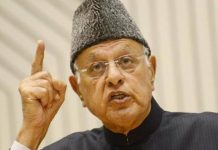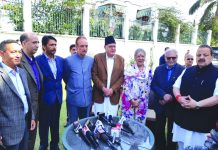
The fertility rate declined from 2.2 children in 2015-16 to the current 2.1 children per woman. Significantly, there is a marked decline in the fertility rate of the Muslim women across India which has played a major role in aiding this population decline. A report by Kulsum Mustafa
The National Family Health Survey (NFHS-5) 2019-2021 data not just heralds a hope on population control it also simultaneously shatters myths about the minority’s rigid attitude against Government of India family planning programmes.
The key finding in the survey state that currently the national fertility rate is 2.1 children per woman. The total fertility rate is 2.0 children per woman. The survey states that the fertility rate declined from 2.2 children in 2015-16. The ideal or wanted fertility rate is 1.6 children per woman. It ranges from 0.9 children in Sikkim to 2.7 children in Meghalaya. According to the report between 1992-93 and 2019-21, the TFR declined from 3.4 children to 2.0 children.
The statistics need to applauded. While these results were possible because of the combination of deploying of the ‘inclusive efforts’ of the government, it cannot be denied that there is a marked decline in the fertility rate of the Muslim women across India and that they have played a major role in aiding this population decline.
“The intensive counseling done by religious preachers and welfare societies and the role of Muslim medical practitioners cannot be underrated in this fertility decline,” said, Professor Tamkin Khan, Chairperson, Department of Obstetrics and Gynaecology, J N Medical College, Aligarh Muslim University.
According to Prof Khan, the group counseling has been an effective way of driving home the point. She said that almost 60 per cent of the patients at the Medical College are Muslims; they understand the message of birth control better when it comes from a Muslim female doctor.
“A woman is most vulnerable post partum. The pain and trauma of childbirth is still fresh in her mind so it is most likely that the family planning counseling will impact her more at this junction,” said Prof Khan stressing that the doctors use this crucial time when the woman is with them and even when she returns for checkup of herself and the baby to impress upon her the importance of keeping a gap in her next child.
To the question whether these women are not guided by the religious belief that children are gifts from Allah and that they should accept their birth graciously and not put any hindrances in the way, Prof Khan had valid arguments.
“We quote to them religious hadees from the Holy Quran which speaks about the parents’ sacred responsibility of the right upbringing of their children whom they have brought into this world,” she said.
She said that during the counseling, they tell them that in case as parents they cannot properly feed and educate the child they are going against the spirit of Islam and are committing a sin. Such logic clears their doubts.
“As birth control options we offer them a basket of choices, but we highly recommend Cooper T. This contraceptive is safe and convenient. It is totally pro-women and while it is for 10 years, it allows a woman total freedom. In fact she need not even tell her husband she is using it if she wishes to do so,” said the professor.
Public Heath Practitioner Mohammad Anas also expresses happiness at the survey report. Familiar with ground realities having put in over 15 years in this field, chiefly with government medical research, Anas, who is now engaged as programme manager with a private firm, says that this has been possible because of the awareness created among the girls through education and the increase in the marriage age.
“Unlike some years back, Muslim families are enrolling their girls not just for primary but higher education too, this has decreased the pressure on them for marriage in teens,” he said.
“Girls are engaged now in education till the age of 22-23. The marriage age which used to be around 15-16 has now gone up to 25. This affects their biological clock and reduces the fertility period,” he said.
He also added that unlike in previous years, now there is more awareness about sex education among adolescents.
He said that families are now very conscious of their socio economic status and the Muslim girls too want to create their own identity and economically empower themselves before taking the step to settle down in matrimony,
Anas’s contention is proved by the report finding data.
“The number of children per woman declines with women’s level of schooling. Women with no schooling have an average of 2.8 children, compared with 1.8 children for women with 12 or more years of schooling.” says the survey.
Late marriages of males and global warming, according to Anas, also affect the potency of male sperms leading to lowering of the fertility rate.
‘High temperature adversely impacts the male sperm production cycle and so does the advancing age. Till 28 years, the sperm production in males is at its peak,” says Anas.
The man who had attempted to shatter many myths associated with the Indian Muslims and proved them with data and facts is none other than the former Chief Election Commissioner of India Mr. SY Quraishi. In his book titled The population myth: Islam, family planning and politics in India, he had stated that myths are being created purposely around the Indian Muslim population in order to “create fear and hostility in the majority Hindu population.” He had through his writing attempted to burst these myths.
Quoting statistics to prove that population explosion is being wrongly blamed on Muslims, he says
“Between 1951 till 2011 Census, a net increase in Muslim population was 13.6 crores and of Hindus 67.6 cr.”
“The demographic ratio of India indeed shows an increase in Muslims from 9.8 in 1951 to 14.2 in 2011, and decline in Hindus from 84.2% to 79.8%. This is an increase of 4.4 percentage points in 60 years.”
To the accusations that Muslims are not adopting family planning faster than Hindus, he said that the gap in their number of children is narrowing. From 1.1 in 1991 it has come down to 0.48.
He is also critical of the Right wing appeal to Hindus to produce 8-10 children in order to ensure that the Muslim population does not take them on. Mr. Quraishi said that unlike these Hindu preachers, the Muslim leaders or scholars have not issued appeals for producing more children.
He has in fact expressed fear that this Hindutava unfounded fears may come as roadblocks in way of family planning measures being promoted by the government.
Quraishi also refuted the myth that Islam encourages polygamy.
“There is a general misconception that Islam encourages polygamy. The reality, however, is different. Islam only permits polygamy subject to two stringent conditions – absolute equality among wives and marrying only widows,” he says.
He said it is totally wrong that Islam is against family planning. He said that nowhere has the Quran prohibited family planning. In fact many verses of Quran & citations from Hadith emphasize quality over numbers, health of women & children and right of children to good upbringing.
The Ex CEC said that what Islam forbids is sterilization but birth-spacing is not only allowed, but it is encouraged.
Categorically stating that fertility is not the Hindu-Muslim Issue, he says, “Fertility of all communities is dependent on socio-economic factors like literacy, income and delivery of family planning services. The level of these conditions varies from region to region”.
For anyone who still does not wish to understand, he had a suggestion that one should look for a developmental priority in Islamic countries, like Iran, Egypt, Indonesia and Bangladesh. He said that in Bangladesh and Indonesia, Imams and mosques actively propagate family planning.
Quraishi said that the only way to reduce fertility is to tackle the real factors and address them headlong. They are literacy, poverty, service delivery, etc.
He suggested more efforts by all communities and especially the Muslim community to dispel myths. He suggested that a fact or resource book be prepared for health staff, communicators or politicians. Political leaders who have so far been indifferent to family planning programmes must be roped in too. Special efforts must be made to educate those who are resistant to family planning.











